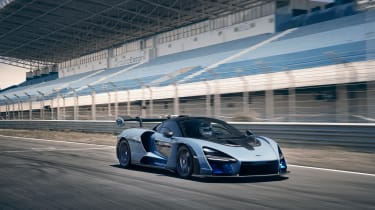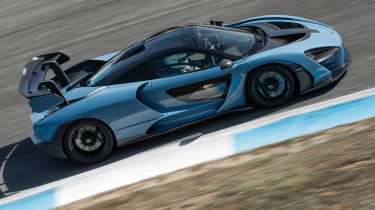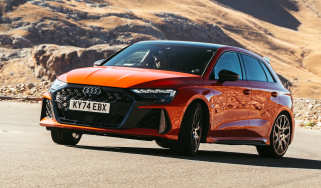McLaren Senna review - the ultimate track driving experience - Ride and Handling
McLaren has taken a legendary name and produced what genuinely could become a legendary car
Ride and Handling
McLaren are at pains to stress that the Senna is compromised in terms of on-road refinement, to the benefit of its abilities on a track. After all, while it is full homologated for road use worldwide - something that sets it apart from numerous other track-specials in itself - it is still a track car first and foremost.
The Senna uses the latest development of the firm’s hydraulically interconnected double wishbone suspension setup, with the emphasis on track ability. It’s called RaceActive Chassis Control 2, with many of the suspension parts fashioned from aluminium to save weight. It’s the adaptive dampers that are connected via the hydraulic system, and when Race mode is selected they not only stiffen considerably, but the ride height is also lowered. There are some very clever algorithms at work making sense of a mind boggling amount of technology.
We’ll be driving the Senna on the public road in due course, and will then update this review accordingly. For how the Senna drives on a racing circuit, click on the ‘Track’ part of this review.
On track
There’s only one way to effectively drive a McLaren Senna on a circuit and that’s to take a deep breath, and then go for it. While the special esp settings for Race mode mean you can go up to and over the limit and still not trigger any electronic intervention, the whole car implores to be driven hard - and the brakes demand heavy use right from the off.
Despite the obvious intimidation factor of driving such a powerful, valuable and extreme car, it’s very soon clear that the Senna is entirely on the driver’s side. Everything is does is so precise, so exact in its response to your inputs, that the bond between man and machine has formed almost before the end of the pit lane is reached. The steering is without fault: beautifully weighted, with wonderful feedback and unerring precision, it allows you to place the Senna exactly where you want it to go. The chassis responds in kind, and as a driver you soon have the confidence that it won’t do anything unexpected. This is down to a number of factors, of course, from the bespoke Pirelli Trofeo R tyres to the downforce being generated, and the single-minded focus of the overall package. It’s not merely that the Senna grips the road so hard, but that it also feels adjustable to the driver in an exploitable way - using the brakes on entry to a corner has the car rotating inwards in a beautifully progressive manner, yet there’s even progressive oversteer on offer once the rapport has been fostered.
High speed corners require rather more bravery, simply because the speeds start to get very significant indeed, and if you’re used to purely mechanical grip then the Senna’s ability to cling on to its chosen line simply leaves the brain scrambled. It takes time to trust that the Senna will indeed stick to the road, but a curve taken flat at nearly 150mph is something to be savoured once you’ve built up to it. And yet in spite of how brilliant it is at accelerating and cornering, it’s how it stops that leaves the biggest impression. The Senna uses a special form of carbon ceramic brake, and this combined with the assistance of the rear wing means that the car stops in almost cartoon fashion. We’ve driven the car at Silverstone and Estoril circuits now, and the approach to the first corner at the latter required a sudden deceleration from 180mph to around 40mph, all of which could be achieved - after screwing up plenty of courage - in less than 200 metres. In such circumstances, the technique is simply to hit the brake pedal as hard as possible - itself totally unnatural at such high speed - and then feel your insides being compressed against the front of your rib cage. For a road car, it is simply otherworldly.





